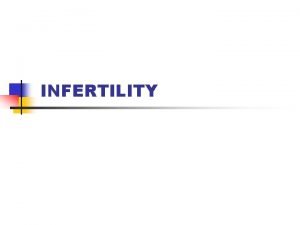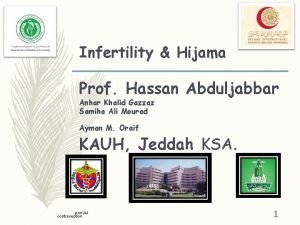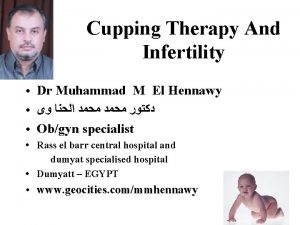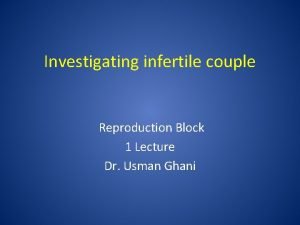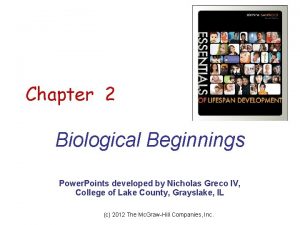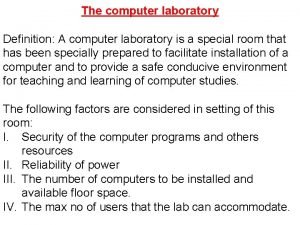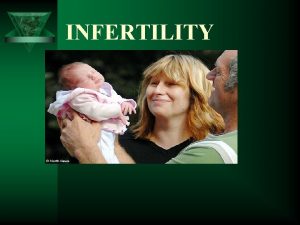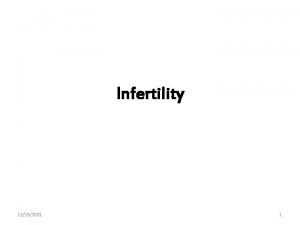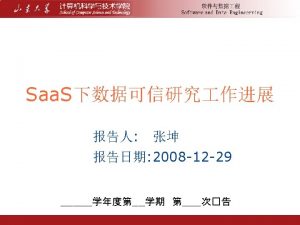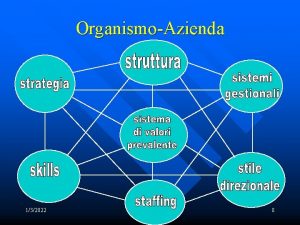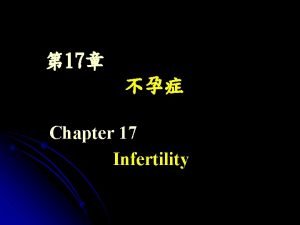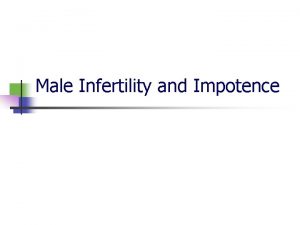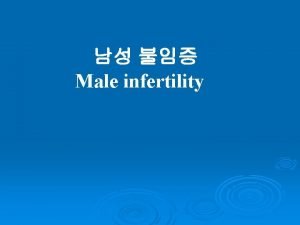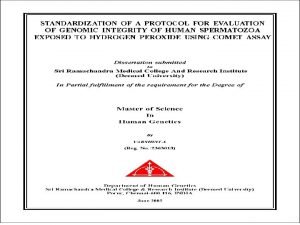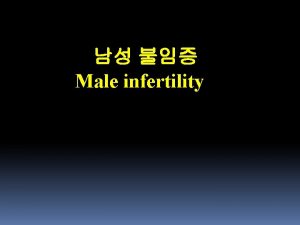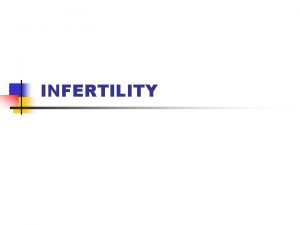Infertility 132022 1 Definition Infertility is defined as



















- Slides: 19

Infertility 1/3/2022 1

Definition • Infertility is defined as the inability of a couple to conceive within 1 year of unprotected regular intercourse. • Sterility implies an intrinsic inability to achieve pregnancy whereas infertility implies a decrease in the ability to conceive and is synonymous with subfertility. • Primary infertility applies to those who have never conceived, whereas • secondary infertility designates those who have conceived at some time in the past. • Fecundity is the probability of achieving a live birth in 1 menstrual cycle. • Fecundability is the chance of conception in one menstrual cycle or the likelihood of conception per month of exposure. • In normal fertile couples having frequent intercourse, the fecundability is estimated to be approximately 20– 25%. 1/3/2022 2

• Prevalence - Infertility affects 10 -15% of reproductive age group - Age of maximum fertility – male 30 years & female 25 years - Chance of conception: Ø 1 month → 25% Ø 6 months → 60% Ø 9 month → 75% Ø 12 months → 80 -85% Ø 18 months → 90% 1/3/2022 3

q. Etiologic distribution - Male factor →→ 25 -40% - Female factor → 40 -55% - Both – 10% - Unexplained – 10% 1/3/2022 4

Causes of Infertility Male Factor • Endocrine disorders • Hypothalamic dysfunction (Kallmann's syndrome) • Pituitary failure (tumor, radiation, surgery) • Hyperprolactinemia (drug, tumor) • Exogenous androgens • Thyroid disorders • Adrenal hyperplasia • Anatomic disorders • Congenital absence of vas deferens • Obstruction of vas deferens • Congenital abnormalities of ejaculatory system 1/3/2022 • • • • Abnormal spermatogenesis Chromosomal abnormalities Mumps orchitis Cryptorchidism Chemical or radiation exposure Abnormal motility Absent cilia (Kartagener's syndrome) Varicocele Antibody formation Sexual dysfunction Retrograde ejaculation Impotence Decreased libido 5

Ovulatory Factor • Central defects • Chronic hyperandrogenemic anovulation • Hyperprolactinemia (drug, tumor, empty selia) • Hypothalamic insufficiency • Pituitary insufficiency (trauma, tumor, congenital) Cervical Factor • Congenital • DES exposure • Müllerian duct abnormality • Acquired • Surgical treatment • Infection 1/3/2022 Pelvic Factor • Infection • Appendicitis • Pelvic inflammatory disease • Uterine adhesions (Asherman's syndrome) • Endometriosis • Structural abnormalities • Diethylstilbestrol (DES) exposure • Failure of normal fusion of the reproductive tract • Myoma 6

q Causes of female infertility 1. Ovulatory dysfunction: 30 -40 % 2. Tubal or peritoneal factor: 30 -40% 3. Endometriosis: 1 -10% 4. Unexplained: 10 -15% 5. Miscellaneous: 10% 1/3/2022 7

Medical History for Female • In utero diethylstilbestrol (DES) exposure • History of pubertal development • Present menstrual cycle characteristics (length, duration, molimina) • Contraceptive history • Prior pregnancies, outcomes • Previous surgeries, especially pelvic • Prior infection • History of abnormal Papanicolau (Pap) smear, treatment • Drugs and medications • General health (diet, weight stability, exercise patterns, review of systems) 1/3/2022 8

Medical History for Male • • • Congenital abnormalities Undescended testes Prior paternity Frequency of intercourse Exposure to toxins Previous surgery Previous infections, treatment Drugs and medications General health (diet, exercise, review of systems) Decreased frequency of shaving 1/3/2022 9

When to evaluate? • After one year • After 6 months in women older than 35 years & after 40 years in men • Approach to infertile couples – general principle: - Both partners at the initial visit - Sympathetic and caring approach - Clear understanding of their needs - Clear understanding and description of investigations required (money and time) - Investigations: least invasive, least costly, least time consuming, effective, practical, directed towards the commonest problem - Investigation and Rx at the same time 1/3/2022 10 - Never be satisfied with a single positive finding

Ø The laboratory and radiologic tests assess four key aspects for fertility in a couple: ü The sperm (male factor) ü The oocyte (ovulatory factor and ovarian reserve) ü Transport and ü Implantation of ova (pelvic factor including fallopian tubes and uterus). Ø Semen Analysis • The male partner should abstain from coitus for 2 – 5 days before collecting the sample and the specimen should be received in the lab within 1 hour of collection. 1/3/2022 11

Evaluation of Male Normal Semen Parameters Liquification 30 minutes Count 20 million/m. L or more Motility > 50% Volume 2 m. L or more Morphology 30% normal Strict criteria > 14% normal p. H 7. 2– 7. 8 White blood cell count < 1 million/m. L 1/3/2022 12

Evaluation of Female Factors Ovulatory Factor Ø An ovulatory dysfunction is responsible for approximately 20– 25% of infertility cases (~40% of female factor infertility). Ø The problem should be investigated first by review of historical factors, including ü the onset of menarche ü present cycle length (intermenstrual interval) ü and presence or absence of premenstrual symptoms (molimina) - such as breast tenderness - bloating, or dysmenorrhea. 1/3/2022 13

ü Signs and symptoms of systemic disease, particularly of hyperthyroidism or hypothyroidism, ü and physical signs of endocrine disease - Hirsutism, galactorrhea, and obesity) should be noted. - The degree and intensity of exercise - a history of weight loss - and complaints of hot flushes all are clinical clues to possible endocrine or ovulatory dysfunction. 1/3/2022 14

Confirmation of Ovulation • If the patient reports a history of mittelschmerz and/or regular menses with molimina the likelihood of the patient having regular ovulatory cycles is very high. • Otherwise, ovulation can be confirmed with a serum progesterone assay performed in the mid-luteal phase or the third week of the cycle. • Progesterone levels of 3 ng/m. L or greater are consistent with ovulation. 1/3/2022 15

• Pelvic ultrasonography can provide evidence for ovulation • The basal body temperature (BBT) elevates by an average of 0. 8 °F during the luteal phase • The use of an endometrial biopsy (EMB) • The cervical mucus changes 1/3/2022 16

vunexplained • No obvious cause for infertility following all standard investigations i. e. semen analysis, ovulation detection, tubal &peritoneal factors, endocrinopathy & post-coital test • With expectant management, 60 % conceive in three years 1/3/2022 17

Treatment v. Couple instructions: • Assurance: when faults found in both, treat both at a time • Optimal body weight • Avoid excessive alcohol ingestion & smoking • Coital problems need to be carefully evaluated by intelligent interrogation 1/3/2022 18

Thank you!!! 1/3/2022 19
 Cul de sacs meaning
Cul de sacs meaning A collection of well defined objects is called
A collection of well defined objects is called Hijama points for male infertility
Hijama points for male infertility Cupping therapy for fertility
Cupping therapy for fertility Female infertility
Female infertility Sherman silber md
Sherman silber md Cystic fibrosis male infertility
Cystic fibrosis male infertility Piecewise function def
Piecewise function def Real world piecewise functions worksheet
Real world piecewise functions worksheet Work physics definition
Work physics definition What is finance
What is finance Strand for cooking
Strand for cooking Usability is defined by 5 quality components
Usability is defined by 5 quality components What is conflick
What is conflick Ambiguously defined triangle
Ambiguously defined triangle Learning can be defined as
Learning can be defined as Cognitive affective personality system
Cognitive affective personality system Meaning of computer laboratory
Meaning of computer laboratory Strategic management is an art or science
Strategic management is an art or science Quantitative study of reactants and products
Quantitative study of reactants and products
